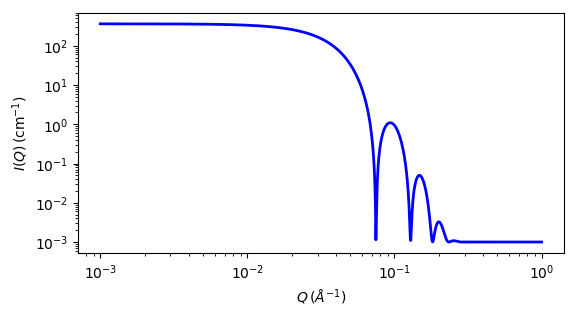fuzzy_sphere¶
Scattering from spherical particles with a fuzzy surface.
Parameter |
Description |
Units |
Default value |
|---|---|---|---|
scale |
Scale factor or Volume fraction |
None |
1 |
background |
Source background |
cm-1 |
0.001 |
sld |
Particle scattering length density |
10-6Å-2 |
1 |
sld_solvent |
Solvent scattering length density |
10-6Å-2 |
3 |
radius |
Sphere radius |
Å |
60 |
fuzziness |
std deviation of Gaussian convolution for interface (must be << radius) |
Å |
10 |
The returned value is scaled to units of cm-1 sr-1, absolute scale.
For information about polarised and magnetic scattering, see the Polarisation/Magnetic Scattering documentation.
Definition
The scattering intensity \(I(q)\) is calculated as:
where the amplitude \(A(q)\) is given as the typical sphere scattering convoluted with a Gaussian to get a gradual drop-off in the scattering length density:
Here \(A(q)^2\) is the form factor, \(P(q)\). The scale is equivalent to the volume fraction of spheres, each of volume, \(V\). Contrast \((\Delta \rho)\) is the difference of scattering length densities of the sphere and the surrounding solvent.
Poly-dispersion in radius and in fuzziness is provided for, though the fuzziness must be kept much smaller than the sphere radius for meaningful results.
From the reference:
The “fuzziness” of the interface is defined by the parameter \(\sigma_\text{fuzzy}\). The particle radius \(R\) represents the radius of the particle where the scattering length density profile decreased to 1/2 of the core density. \(\sigma_\text{fuzzy}\) is the width of the smeared particle surface; i.e., the standard deviation from the average height of the fuzzy interface. The inner regions of the microgel that display a higher density are described by the radial box profile extending to a radius of approximately \(R_\text{box} \sim R - 2 \sigma\). The profile approaches zero as \(R_\text{sans} \sim R + 2\sigma\).
For 2D data: The 2D scattering intensity is calculated in the same way as 1D, where the \(q\) vector is defined as

Fig. 81 1D plot corresponding to the default parameters of the model.¶
Source
fuzzy_sphere.py
\(\ \star\ \) fuzzy_sphere.c
\(\ \star\ \) sas_3j1x_x.c
References
M Stieger, J. S Pedersen, P Lindner, W Richtering, Langmuir, 20 (2004) 7283-7292
Authorship and Verification
Author:
Last Modified by:
Last Reviewed by: